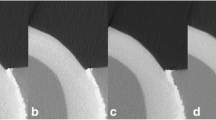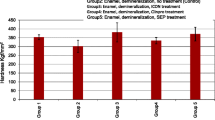Abstract
Objectives
The aim of this study was to assess the effect of two sealants and two varnishes on the prevention of enamel demineralization, as well as the effect of inattentive surplus enamel-etching by a self-etching primer (SEP).
Materials and methods
The sealants ProSeal and Clinpro and the varnishes Protecto and FluorProtector were investigated. For inattentive surplus enamel-etching, Transbond Plus SEP was used. The teeth (N = 75) underwent a pH-cycling for 4 weeks and were examined by weekly consecutive μCT scans (t1–t4) to determine mineral loss (ΔZ Equivalent) and lesion depth (Ld). At t4, we also assessed the fluorescence change (ΔF).
Results
For ProSeal, no lesions could be detected. In contrast, we found isolated lesions in the area treated with Clinpro. Teeth with inattentive surplus enamel-etching showed always a higher ΔZ Eqivalent. However, this was not statistically significantly different compared to the teeth treated with the varnishes. The adjacent untreated enamel (except the SEP-treated teeth) always showed significantly more demineralization than any of the treated areas. The ΔF partially confirmed these results.
Conclusion
No lesions were shown in the area of application of ProSeal. The other materials did not sufficiently protect the enamel; however, a protective effect of all materials was obvious when comparing the bracket-periphery with the adjacent untreated enamel. Additionally, the area of SEP application showed almost always a significantly less demineralization in comparison to that found on the adjacent untreated enamel.
Clinical relevance
The bracket-periphery was not always sufficiently protected. The adjacent untreated enamel did not benefit from the bracket-periphery treatment.


Similar content being viewed by others
References
Tufekci E, Dixon JS, Gunsolley JC, Lindauer SJ (2011) Prevalence of white spot lesions during orthodontic treatment with fixed appliances. Angle Orthod 81:206–210. doi:10.2319/051710-262.1
Ogaard B (1989) Prevalence of white spot lesions in 19-year-olds: a study on untreated and orthodontically treated persons 5 years after treatment. Am J Orthod Dentofac Orthop Off Publ Am Assoc Orthod Constit Soc Am Board Orthod 96:423–427
Hadler-Olsen S, Sandvik K, El-Agroudi MA, Ogaard B (2012) The incidence of caries and white spot lesions in orthodontically treated adolescents with a comprehensive caries prophylactic regimen—a prospective study. Eur J Orthod 34:633–639. doi:10.1093/ejo/cjr068
Behnan SM, Arruda AO, Gonzalez-Cabezas C, Sohn W, Peters MC (2010) In-vitro evaluation of various treatments to prevent demineralization next to orthodontic brackets. Am J Orthod Dentofac Orthop Off Publ Am Assoc Orthod Constit Soc Am Board Orthod 138:712 e1–7. doi:10.1016/j.ajodo.2010.05.014, discussion 712–3
Buren JL, Staley RN, Wefel J, Qian F (2008) Inhibition of enamel demineralization by an enamel sealant, Pro Seal: an in-vitro study. Am J Orthod Dentofac Orthop Off Publ Am Assoc Orthod Constit Soc Am Board Orthod 133:S88–S94. doi:10.1016/j.ajodo.2007.01.025
Ghiz MA, Ngan P, Kao E, Martin C, Gunel E (2009) Effects of sealant and self-etching primer on enamel decalcification. Part II: an in-vivo study. Am J Orthod Dentofac Orthop Off Publ Am Assoc Orthod Constit Soc Am Board Orthod 135:206–213. doi:10.1016/j.ajodo.2007.02.060
Hu W, Featherstone JD (2005) Prevention of enamel demineralization: an in-vitro study using light-cured filled sealant. Am J Orthod Dentofac Orthop Off Publ Am Assoc Orthod Constit Soc Am Board Orthod 128:592–600. doi:10.1016/j.ajodo.2004.07.046, quiz 670
Soliman MM, Bishara SE, Wefel J, Heilman J, Warren JJ (2006) Fluoride release rate from an orthodontic sealant and its clinical implications. Angle Orthod 76:282–288. doi:10.1043/0003-3219(2006)076[0282:FRRFAO]2.0.CO;2
Demito CF, Rodrigues GV, Ramos AL, Bowman SJ (2011) Efficacy of a fluoride varnish in preventing white-spot lesions as measured with laser fluorescence. J Clin Orthod JCO 45:25–29, quiz 40
Ogaard B, Larsson E, Henriksson T, Birkhed D, Bishara SE (2001) Effects of combined application of antimicrobial and fluoride varnishes in orthodontic patients. Am J Orthod Dentofac Orthop Off Publ Am Assoc Orthod Constit Soc Am Board Orthod 120:28–35. doi:10.1067/mod.2001.114644
Stecksen-Blicks C, Renfors G, Oscarson ND, Bergstrand F, Twetman S (2007) Caries-preventive effectiveness of a fluoride varnish: a randomized controlled trial in adolescents with fixed orthodontic appliances. Caries Res 41:455–459. doi:10.1159/000107932
Knosel M, Bojes M, Jung K, Ziebolz D (2012) Increased susceptibility for white spot lesions by surplus orthodontic etching exceeding bracket base area. Am J Orthod Dentofac Orthop Off Publ Am Assoc Orthod Constit Soc Am Board Orthod 141:574–582. doi:10.1016/j.ajodo.2011.11.017
Korbmacher-Steiner HM, Schilling AF, Huck LG, Kahl-Nieke B, Amling M (2013) Laboratory evaluation of toothbrush/toothpaste abrasion resistance after smooth enamel surface sealing. Clin Oral Investig 17:765–774. doi:10.1007/s00784-012-0771-8
Chung CK, Millett DT, Creanor SL, Gilmour WH, Foye RH (1998) Fluoride release and cariostatic ability of a compomer and a resin-modified glass ionomer cement used for orthodontic bonding. J Dent 26:533–538
Gorton J, Featherstone JD (2003) In vivo inhibition of demineralization around orthodontic brackets. Am J Orthod Dentofac Orthop Off Publ Am Assoc Orthod Constit Soc Am Board Orthod 123:10–14. doi:10.1067/mod.2003.47
Paschos E, Kleinschrodt T, Clementino-Luedemann T, Huth KC, Hickel R, Kunzelmann KH, Rudzki-Janson I (2009) Effect of different bonding agents on prevention of enamel demineralization around orthodontic brackets. Am J Orthod Dentofac Orthop Off Publ Am Assoc Orthod Constit Soc Am Board Orthod 135:603–612. doi:10.1016/j.ajodo.2007.11.028
Li N, Nikaido T, Takagaki T, Sadr A, Makishi P, Chen J, Tagami J (2010) The role of functional monomers in bonding to enamel: acid-base resistant zone and bonding performance. J Dent 38:722–730. doi:10.1016/j.jdent.2010.05.015
Davis GR, Evershed AN, Mills D (2013) Quantitative high contrast x-ray microtomography for dental research. J Dent. doi:10.1016/j.jdent.2013.01.010
ten Cate JM, Duijsters PP (1982) Alternating demineralization and remineralization of artificial enamel lesions. Caries Res 16:201–210
Birkeland JM (1973) The effect of pH on the interaction of fluoride and salivary ions. Caries Res 7:11–18
Todd MA, Staley RN, Kanellis MJ, Donly KJ, Wefel JS (1999) Effect of a fluoride varnish on demineralization adjacent to orthodontic brackets. Am J Orthod Dentofac Orthop Off Publ Am Assoc Orthod Constit Soc Am Board Orthod 116:159–167
Angmar B, Carlstrom D, Glas JE (1963) Studies on the ultrastructure of dental enamel. IV. The mineralization of normal human enamel. J Ultrastruct Res 8:12–23
ten Cate JM, Dundon KA, Vernon PG, Damato FA, Huntington E, Exterkate RA, Wefel JS, Jordan T, Stephen KW, Roberts AJ (1996) Preparation and measurement of artificial enamel lesions, a four-laboratory ring test. Caries Res 30:400–407
Ogaard B, Rolla G, Arends J (1988) Orthodontic appliances and enamel demineralization. Part 1. Lesion development. Am J Orthod Dentofac Orthop Off Publ Am Assoc Orthod Constit Soc Am Board Orthod 94:68–73
White DJ, Featherstone JD (1987) A longitudinal microhardness analysis of fluoride dentifrice effects on lesion progression in vitro. Caries Res 21:502–512
Benson PE, Parkin N, Millett DT, Dyer FE, Vine S and Shah A (2004) Fluorides for the prevention of white spots on teeth during fixed brace treatment. Cochrane Database Syst Rev:CD003809. doi: 10.1002/14651858.CD003809.pub2
Benson PE, Shah AA, Millett DT, Dyer F, Parkin N, Vine RS (2005) Fluorides, orthodontics and demineralization: a systematic review. J Orthod 32:102–114. doi:10.1179/146531205225021033
Geiger AM, Gorelick L, Gwinnett AJ, Benson BJ (1992) Reducing white spot lesions in orthodontic populations with fluoride rinsing. Am J Orthod Dentofac Orthop Off Publ Am Assoc Orthod Constit Soc Am Board Orthod 101:403–407
Geiger AM, Gorelick L, Gwinnett AJ, Griswold PG (1988) The effect of a fluoride program on white spot formation during orthodontic treatment. Am J Orthod Dentofac Orthop Off Publ Am Assoc Orthod Constit Soc Am Board Orthod 93:29–37
Ogaard B, Alm AA, Larsson E, Adolfsson U (2006) A prospective, randomized clinical study on the effects of an amine fluoride/stannous fluoride toothpaste/mouthrinse on plaque, gingivitis and initial caries lesion development in orthodontic patients. Eur J Orthod 28:8–12. doi:10.1093/ejo/cji075
Buzalaf MA, Hannas AR, Magalhaes AC, Rios D, Honorio HM, Delbem AC (2010) pH-cycling models for in vitro evaluation of the efficacy of fluoridated dentifrices for caries control: strengths and limitations. J Appl Oral Scie Rev FOB 18:316–334
Lynch RJ, Mony U, ten Cate JM (2007) Effect of lesion characteristics and mineralizing solution type on enamel remineralization in vitro. Caries Res 41:257–262. doi:10.1159/000101914
Tanaka M, Ono H, Kadoma Y, Imai Y (1987) Incorporation into human enamel of fluoride slowly released from a sealant in vivo. J Dent Res 66:1591–1593
Lobo MM, Pecharki GD, Tengan C, da Silva DD, da Tagliaferro EP, Napimoga MH (2005) Fluoride-releasing capacity and cariostatic effect provided by sealants. J Oral Sci 47:35–41
Salar DV, Garcia-Godoy F, Flaitz CM, Hicks MJ (2007) Potential inhibition of demineralization in vitro by fluoride-releasing sealants. J Am Dent Assoc 138:502–506
Clementino-Luedemann TN, Kunzelmann KH (2006) Mineral concentration of natural human teeth by a commercial micro-CT. Dent Mater J 25:113–119
Conflict of interest
The authors declare that they have no conflict of interest.
Author information
Authors and Affiliations
Corresponding author
Rights and permissions
About this article
Cite this article
Paschos, E., Rosenbeck, K.A., Huth, K.C. et al. Evaluation of the effect of bracket-periphery treatment on prevention of enamel demineralization by consecutive μCT scans. Clin Oral Invest 19, 1519–1526 (2015). https://doi.org/10.1007/s00784-014-1351-x
Received:
Accepted:
Published:
Issue Date:
DOI: https://doi.org/10.1007/s00784-014-1351-x




